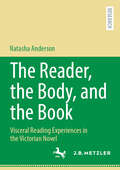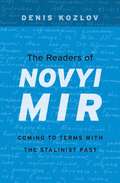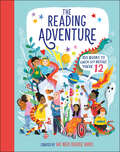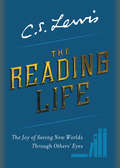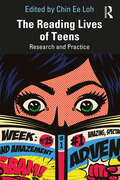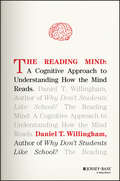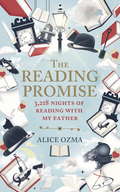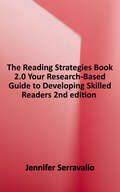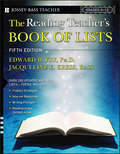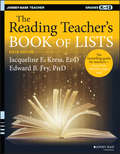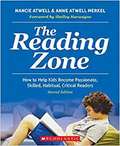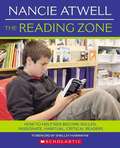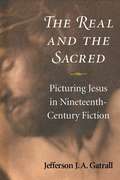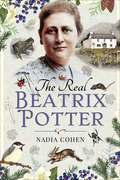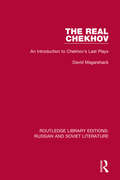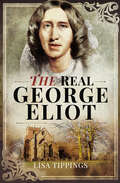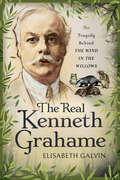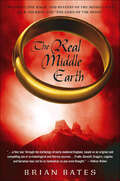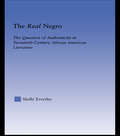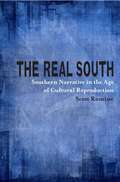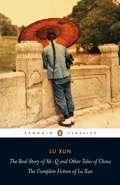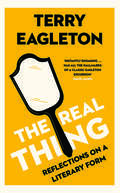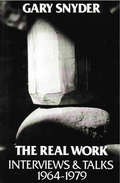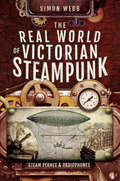- Table View
- List View
The Reader, the Body, and the Book: Visceral Reading Experiences in the Victorian Novel
by Natasha AndersonHow do books dazzle, disgust, or delight audiences? What entices readers to track characters&’ trials and tribulations? Why do stories echo across the ages with their intensity? Books with vibrant, somatic elements prompt us to identify with protagonists who fall in love, flee from pursuers, and fight for survival, enhancing the awareness of our own bodies. This transatlantic, diachronic study of 19th-century literature analyzes the rising complexity of sensorimotor descriptions in four major Victorian novels: Anne Brontë&’s The Tenant of Wildfell Hall, Charlotte Brontë&’s Villette, Henry James&’s The Portrait of a Lady, and Thomas Hardy&’s Tess of the d&’Urbervilles. Based on phenomenological insights of French philosophers Maurice Merleau-Ponty and Paul Ricœur, this groundbreaking research on visceral reading experiences in British and U.S. American fiction illuminates the immersive appeal of bodily motions and sensations in books, film adaptions, and digital resources of the 21st century.
The Readers of Novyi Mir
by Denis KozlovIn the “Thaw” following Stalin’s death, probing conversations about the nation’s violent past took place in the literary journal Novyi mir (New World). Readers’ letters reveal that discussion of the Terror was central to intellectual and political life during the USSR’s last decades. Denis Kozlov shows how minds change, even in a closed society.
The Reading Adventure: 100 Books to Check Out Before You're 12
by DK We Need Diverse BooksDiscover your next read with this carefully curated list from We Need Diverse Books. Check out 100 must-read books to try before you're 12! Packed with reviews, recommendations, and exclusive author interviews, The Reading Adventure: 100 Books To Check Out Before You're 12 will inspire young readers to discover a diverse range of books beyond the curriculum. From mystery to autobiography, the book is organised by genre, so you can jump to the section that interests you the most. Each entry has a key theme box so you can immediately see if the book is something you'll enjoy. Helpful signposts lead readers to another book the author thinks they'll enjoy. Hidden gems, award-winners, classics, and current bestsellers are brought to life by vibrant illustrations. There's truly something for everyone!Vibrant and educational, you can explore:- 15 exclusive author interviews, including Jason Reynolds, Meg Medina and Linda Sue Park.- Organized by genre and theme, so the reader can find a book based on their interests.- Discover 100 book recommendations aimed at 7-12 year olds with vibrant and fun illustrations.- Running categories organized by interest and theme.- Endmatter includes writing activities, and an index.- Bold original illustrations by a range of artists bring the books to life.Developed in collaboration with We Need Diverse Books - a non-profit with a mission to create a world where everyone can find themselves in the pages of a book - young readers can explore a variety of awe-inspiring and thought-provoking books, with titles including: High Rise Mystery by Sharna Jackson, A Kind of Spark, by Elle McNicoll, From The Mixed Up Files of Mrs Basil E Frankweiler by E.L. Konigsburg, Front Desk by Kelly Yang, and many more. Ideal for caregivers and gift givers of both voracious and reluctant readers within the 7-12 age group, as well as caregivers of neurodivergent children, children with a disability, and children of color seeking greater representation in literature.
The Reading Life: The Joy of Seeing New Worlds Through Others' Eyes
by C. S. LewisThe revered teacher and bestselling author of such classic Christian works as Mere Christianity and The Screwtape Letters reflects on the power, importance, and joy of a life dedicated to reading books in this delightful collection drawn from his wide body of writings.More than fifty years after his death, revered intellectual and teacher C. S. Lewis continues to speak to readers, thanks not only to his intellectual insights on Christianity but also his wondrous creative works and deep reflections on the literature that influenced his life. Beloved for his instructive novels including The Screwtape Letters, The Great Divorce, and The Chronicles of Narnia as well as his philosophical books that explored theology and Christian life, Lewis was a life-long writer and book lover.Cultivated from his many essays, articles, and letters, as well as his classic works, How to Read provides guidance and reflections on the love and enjoyment of books. Engaging and enlightening, this well-rounded collection includes Lewis’ reflections on science fiction, why children’s literature is for readers of all ages, and why we should read two old books for every new one.A window into the thoughts of one of the greatest public intellectuals of our time, this collection reveals not only why Lewis loved the written word, but what it means to learn through literature from one of our wisest and most enduring teachers.
The Reading Lives of Teens: Research and Practice
by Chin Ee LohIn these changing times of global flows of media and technologies and reports of declining reading enjoyment, researchers, policymakers and educators need to engage anew with essential issues of what counts as reading, what kinds of reading matter and how to support teen reading engagement in school and out-of-school settings.Bringing together contributions from well-known and emerging adolescent literacy researchers from different disciplinary perspectives, this edited collection consolidates contemporary research on teens’ volitional print and digital reading, whether in school or out-of-school contexts. The first part of the book offers overviews of what teens are reading, followed by chapters on community support on reading and new ways of researching teen reading. With chapters from North America, Europe, Australia, Asia and the Middle East, the collection will offer multifaceted and complex insights into what, how and why teens read in different contexts. Reflection questions at the end of each chapter encourage readers to consider how the research can be applied in their own research, policy and practice contexts.This book will be of interest to researchers, policymakers and educators who are invested in supporting adolescent-engaged reading with evidence-based policies and strategies.
The Reading Mind: A Cognitive Approach to Understanding How the Mind Reads
by Daniel T. WillinghamPRAISE FOR THE READING MIND "Willingham's ability to make cognitive research on reading coherent and comprehensible is exceptional. This book should be standard fare in every doctoral education course on reading." —Isabel L. Beck, Professor Emerita, School of Education, University of Pittsburgh "This is another of Willingham's essential books for educational professionals, and anyone else interested in the reading process—telling them the cognitive science and practical implications of research in the domain of reading. No one does this kind of book better than Willingham!" —Keith E. Stanovich, author of Progress in Understanding Reading and The Rationality Quotient "Willingham captures the magic of reading while simultaneously demystifying how we read. He brings key experimental findings to light as he takes us on the journey from recognizing individual words to constructing meaning from text. Beautifully written, clear and accessible, yet still embracing complexities rather than shying away from them—this book is essential reading for anyone interested in how we read." —Kate Nation, professor of Experimental Psychology, University of Oxford; fellow and tutor in Psychology, St. John's College "What goes on in the mind as we read? How do people learn to read? What motivates some to read more than others? For those curious about these questions, and for those who care about children learning to read and growing as readers, this delightful book explains this highly complex topic through fascinating studies and lively examples. With probing questions included, The Reading Mind will make a terrific book club read or textbook." —Ellen McIntyre, dean and professor, College of Education, University of North Carolina, Charlotte "Willingham's work will deepen your understanding of the many facets of reading and literacy, as well as how the brain processes what amounts to an astoundingly complex and historically unlikely process. This book should be required reading for anyone with a vested interest in the written word." —Kristofor Lauricella, History teacher, High School for Youth & Community Development, Brooklyn, New York
The Reading Promise: 3,218 nights of reading with my father
by Alice OzmaWhen Alice was nine years old, she and her father - a beloved school librarian - made a promise to read aloud together for 100 consecutive nights. Upon reaching their goal, they celebrated over pancakes, but it was clear that neither wanted to let go of what had become their reading ritual. They decided to continue what became known as The Streak for as long as they possibly could.From L. Frank Baum to Dickens to J.K. Rowling to Shakespeare, Alice's father read to her every night without fail until the day she entered college, a remarkable eight years later. In this deeply affecting memoir, Alice tells the story of her relationship with the extraordinary man who raised her - from his steadying hand on the back of her wobbly bike to his one-man crusade to keep reading in schools - the words they shared and the spaces in between. Alice poignantly illustrates the unbreakable parent-child bond, the books they treasured, and the life lessons learned along the way.
The Reading Strategies Book 2. 0: Your Research-Based Guide to Developing Skilled Readers
by Jennifer SerravalloEvidence-based, responsive instruction made easier. - 100 new and 200 heavily revised strategies - 700+ references or links to research studies - Skill progressions for progress monitoring - 200 new student-facing charts - New strategies for advanced middle school readers - Recently published mentor texts used in lesson examples Serravallo brings a practical and proven approach to helping teachers help kids develop as skilled readers. The Reading Strategies Book 2.0 is designed to work in every K-8 classroom, providing strategies and lesson plans for every type of reader. The user-friendly design of The Reading Strategies Book 2.0 makes it easy to find strategies, prompts, and tips that meet every student where they are now. Save prep time and support readers' progress toward skills mastery with classroom-ready features such as revised lesson language with updated mentor texts, teaching tips with advice for differentiation, and mostly new student-facing charts. Whether you are looking for powerful and engaging lessons for whole-class teaching, need to supplement your core curriculum with small-group instruction, want to improve the quality of content-area instruction, or need ideas for intervention, The Reading Strategies Book 2.0 will help you connect research to practice.
The Reading Strategies Book: Your Everything Guide To Developing Skilled Readers
by Jennifer SerravalloWith hit books that support strategic reading through conferring, small groups, and assessment, Jen Serravallo gets emails almost daily asking, "Isn't there a book of the strategies themselves?" Now there is. <P><P> "Strategies make the often invisible work of reading actionable and visible," Jen writes. In The Reading Strategies Book, she collects 300 strategies to share with readers in support of thirteen goals-everything from fluency to literary analysis. Each strategy is cross-linked to skills, genres, and Fountas & Pinnell reading levels to give you just-right teaching, just in time. With Jen's help you'll: <br>develop goals for every reader <br>give students step-by-step strategies for skilled reading <br>guide readers with prompts aligned to the strategies <br>adjust instruction to meet individual needs with Jen's Teaching Tips <br>craft demonstrations and explanations with her Lesson Language <br>learn more with Hat Tips to the work of influential teacher-authors. <P><P>Whether you use readers workshop, Daily 5/CAFE, guided reading, balanced reading, a core reading program, whole-class novels, or any other approach, The Reading Strategies Book will complement and extend your teaching. Rely on it to plan and implement goal-directed, differentiated instruction for individuals, small groups, and whole classes. <P><P> "We offer strategies to readers to put the work in doable terms for those who are still practicing," writes Jen Serravallo. "The goal is not that they can do the steps of the strategy but that they become more comfortable and competent with a new skill." With The Reading Strategies Book, you'll have ways to help your readers make progress every day. <P><P> Visit heinemann.com/readingstrategiesbook/ where you'll find blog posts, videos from Jen Serravallo, community features, and more information on The Reading Strategies Book.
The Reading Teacher's Book of Lists
by Edward B. Fry Jacqueline E. KressThe essential handbook for reading teachers, now aligned with the Common Core The Reading Teacher's Book of Lists is the definitive instructional resource for anyone who teaches reading or works in a K-12 English language arts-related field. Newly revised and ready for instant application, this top seller provides up-to-date reading, writing, and language content in more than 240 lists for developing targeted instruction, plus section briefs linking content to research-based teaching practices. This new sixth edition includes a guide that maps the lists to specific Common Core standards for easy lesson planning, and features fifty brand-new lists on: academic and domain-specific vocabulary, foundation skills, rhyming words, second language development, context clues, and more. This edition also includes an expanded writing section that covers registers, signal and transition words, and writers' craft. Brimming with practical examples, key words, teaching ideas, and activities that can be used as-is or adapted to students' needs, these lists are ready to differentiate instruction for an individual student, small-group, or planning multilevel instruction for your whole class. Reading is the center of all school curricula due to recent state and federal initiatives including rigorous standards and new assessments. This book allows to you skip years of curating content and dive right into the classroom armed with smart, relevant, and effective plans. Develop focused learning materials quickly and easily Create unit-specific Common Core aligned lesson plans Link classroom practice to key research in reading, language arts and learning Adapt ready-made ideas to any classroom or level It's more important than ever for students to have access to quality literacy instruction. Timely, up to date, and distinctively smart, The Reading Teacher's Book of Lists should be on every English language arts teacher's desk, librarian's shelf, literacy coach's resource list, and reading professor's radar.
The Reading Teacher's Book of Lists (J-B Ed: Book of Lists)
by Edward B. Fry Jacqueline E. KressThe essential handbook for reading teachers, now aligned with the Common Core The Reading Teacher's Book of Lists is the definitive instructional resource for anyone who teaches reading or works in a K-12 English language arts-related field. Newly revised and ready for instant application, this top seller provides up-to-date reading, writing, and language content in more than 240 lists for developing targeted instruction, plus section briefs linking content to research-based teaching practices. This new sixth edition includes a guide that maps the lists to specific Common Core standards for easy lesson planning, and features fifty brand-new lists on: academic and domain-specific vocabulary, foundation skills, rhyming words, second language development, context clues, and more. This edition also includes an expanded writing section that covers registers, signal and transition words, and writers' craft. Brimming with practical examples, key words, teaching ideas, and activities that can be used as-is or adapted to students' needs, these lists are ready to differentiate instruction for an individual student, small-group, or planning multilevel instruction for your whole class. Reading is the center of all school curricula due to recent state and federal initiatives including rigorous standards and new assessments. This book allows to you skip years of curating content and dive right into the classroom armed with smart, relevant, and effective plans. Develop focused learning materials quickly and easily Create unit-specific Common Core aligned lesson plans Link classroom practice to key research in reading, language arts and learning Adapt ready-made ideas to any classroom or level It's more important than ever for students to have access to quality literacy instruction. Timely, up to date, and distinctively smart, The Reading Teacher's Book of Lists should be on every English language arts teacher's desk, librarian's shelf, literacy coach's resource list, and reading professor's radar.
The Reading Zone: How To Help Kids Become Passionate, Skilled, Habitual, Critical Readers
by Nancie Atwell Ann Atwell MerkelDecades of expert teaching and thoughtful observation of readers inform this expanded second edition of The Reading Zone. Dynamic teaching and writing partners, mother and daughter Atwell and Atwell Merkel show how to teach reading as a personal art―a way to develop passionate, critical readers for life―and how to build a schoolwide reading culture on self-selected, voluminous reading. The authors describe the top ten conditions for making engaged classroom reading possible for students at all levels and share the ideas and structures that have helped their own students succeed.
The Reading Zone: How to Help Kids Become Skilled, Passionate, Habitual, Critical Readers
by Nancie AtwellLong an advocate of frequent, voluminous reading in schools, the author draws on evidence gathered in twenty years of classroom teaching to make the case for reading workshop more powerful than ever. The book establishes the top ten conditions for making engaged classroom reading possible for students at all levels and provides the practical support and structures necessary for achieving them.
The Real And The Sacred: Picturing Jesus In Nineteenth-century Fiction
by Jefferson J. A. GatrallThe figure of Jesus appears as a character in dozens of nineteenth-century novels, including works by Balzac, Flaubert, Dickens, Dostoevsky, and others. The Real and the Sacred focuses in particular on two fiction genres: the Jesus redivivus tale and the Jesus novel. In the former, Christ makes surprise visits to earth, from rural Flanders (Balzac) and Muscovy (Turgenev) to the bustling streets of Paris (Flaubert), Seville (Dostoevsky), Berlin, and Boston. In the latter, the historical Jesus wanders through the picturesque towns and plains of first-century Galilee and Judea, attracting followers and enemies. In short, authors subjected Christ, the second person of the Christian trinity, to the realist norms of secular fiction. Thus the Jesus of nineteenth-century fiction was both situated within a specific time and place, whether ancient or modern, and positioned before the gaze of increasingly daring literary portraitists. The highest artistic challenge for authors was to paint, using mere words, a faithful picture of Jesus in all his humanity. The incongruity of a sacred figure inhabiting secular literary forms nevertheless tested the limits of modern realist style no less than the doctrine of Christ’s divinity. The international “quest of the historical Jesus” has been amply documented within the context of nineteenth-century biblical scholarship. Yet there has been no broad-based comparative study devoted to the depiction of Jesus in prose fiction over the same time period. The Real and the Sacred offers a comprehensive survey of this body of fiction, examining both the range of its Christ types and the varying formal means through which these types were represented. The nineteenth century—despite forecasts of God's death at the time—not only revived older Christ types but also witnessed the rise of new ones, including le Christ proletaire, the Mormon Christ, the Buddhist Christ, and the Tolstoyan Christ. Novelists played a crucial role in the invention and popularization of the historical Jesus in particular, one of modernity's major figures. These pioneering works of fiction, written by authors of diverse religious and national backgrounds, laid the formal groundwork for an enduring fascination with the historical Jesus in later fiction and film, from Mikhail Bulgakov's Master and Margarita to Mel Gibson's The Passion of the Christ. The book is enhanced by a gallery of illustrations of the historical Jesus as depicted by nineteenth-century artists.
The Real Beatrix Potter
by Nadia CohenA revealing and surprising biography of the woman who defied Victorian expectations and gave the world Peter Rabbit. Beatrix Potter&’s children&’s books have enchanted generations of young readers who adored the characters she created as well as her distinctive illustrations. Born into a typically repressed Victorian family, Beatrix was expected to achieve little more than finding herself a rich husband, and thus her parents felt there was no point in bothering to educate her. But the Potters underestimated their daughter. Stifled by the lack of stimulation, she educated herself in art and science, and developed a great love of the natural world. The success of The Tale of Peter Rabbit proved her to be creative genius who could have become the toast of the London literary scene—but when her fiancé tragically died, Beatrix retreated to the Lake District where she reinvented herself as a successful farmer, a canny businesswoman, and an early environmental pioneer. Passionately campaigning to save the area from development, she helped establish the National Trust, and despite her great wealth Beatrix lived out her days in humble anonymity. From a journalist who has authored biographies of Roald Dahl and A.A. Milne, this is an in-depth look at the woman behind the beloved books.
The Real Chekhov: An Introduction to Chekhov's Last Plays (Routledge Library Editions: Russian and Soviet Literature #9)
by David MagarshackWhat is Chekhov’s method of ensuring audience participation? What does his stage direction ‘through tears’ mean? What happens between the first and second acts of The Seagull? Is there any reason for the despondency in Chekhov’s drama? This book, first published in 1972, discusses these questions and many other issues around Chekhov’s last four plays. David Magarshack, the leading translator and biography of many of Russia’s greatest writers, closely examines Chekhov’s work for the relevant facts about his writing, and demonstrates that no reliance should be placed on the so-called subtext which can introduce all sorts of irrelevancies arising from pre-conceived ideas about the plays. A careful reading of Chekhov’s text itself is all that is needed to correct the familiar distortions of his characters and themes.
The Real George Eliott
by Lisa TippingsThe Real George Eliot revisits the life of the groundbreaking nineteenth century novelist. Eliot was a writer who explored such important questions as the role of women in society and the education they were allowed to access, religion and the restrictions it could sometimes place on individuals, and the struggle between a person’s public and private persona. Her own private life was the cause of much speculation and notoriety. Eliot chose to ignore most of the conventions of Victorian society in order to pursue her own happiness, and her relationship with George Henry Lewes scandalized many members of ‘polite’ society. Regardless of this, however, she overcame such prejudice and in later life enjoyed the company of some of the greatest thinkers and academics of the time, and this is a testament to her formidable intelligence. The fact that she is still so widely read today, is a sign of the longevity of her skills as a writer.
The Real Kenneth Grahame: The Tragedy Behind The Wind in the Willows
by Elisabeth GalvinHe wrote one of the most quintessentially English books, yet Kenneth Grahame (1859 – 1932) was a Scot. He was four years old when his mother died and his father became an alcoholic, so Kenneth grew up with his grandmother who lived on the banks of the beloved River Thames. Forced to abandon his dreams of studying at Oxford, he was accepted as a clerk at the Bank of England where he became one of the youngest men to be made company secretary. He narrowly escaped death in 1903 when he was mistaken for the Bank’s governor and shot at several times. He wrote secretly in his spare time for magazines and became a contemporary of contributors including Rudyard Kipling, George Bernard Shaw and WB Yeats. Kenneth’s first book, Pagan Papers (1893) initiated his success, followed by The Golden Age (1895) and Dream Days (1898), which turned him into a celebrated author. Ironically, his most famous novel today was the least successful during his lifetime: The Wind in the Willows (1908) originated as letters to his disabled son, who was later found dead on a train line after a suspected suicide. Kenneth never recovered from the tragedy and died with a broken heart in earshot of the River Thames. His widow, Elspeth, dedicated the rest of her life to preserving her husband’s name and promoting his work.
The Real Middle Earth: Exploring the Magic and Mystery of the Middle Ages, J.R.R. Tolkien, and "The Lord of the Rings"
by Brian BatesJ.R.R. Tolkien claimed that he based the land of Middle Earth on a real place. The Real Middle Earth brings alive, for the first time, the very real civilization in which those who lived had a vision of life animated by beings beyond the material world. Magic was real to these people and they believed their universe was held together by an interlaced web of golden threads visible only to wizards. At its center was Middle Earth, a place peopled by humans, but imbued with spiritual power. It was a real realm that stretched from Old England to Scandinavia and across to western Europe, encompassing Celts, Anglo Saxons and Vikings. Looking first at the rich and varied tribes who made up the populace of this mystical land, Bates looks at how the people lived their daily lives in a world of magic and mystery. Using archaeological, historical, and psychological research, Brian Bates breathes life into this civilization of two thousand years ago in a book that every Tolkien fan will want.
The Real Negro: The Question of Authenticity in Twentieth-Century African American Literature (Literary Criticism And Cultural Theory Ser.)
by Shelly EversleyIn this book, Shelly Eversley historicizes the demand for racial authenticity - what Zora Neale Hurston called 'the real Negro' - in twentieth-century American literature. Eversley argues that the modern emergence of the interest in 'the real Negro' transforms the question of what race an author belongs into a question of what it takes to belong to
The Real South: Southern Narrative in the Age of Cultural Reproduction (Southern Literary Studies)
by Scott RomineIn this stimulating study, Scott Romine explores the impact of globalization on contemporary southern culture and the South's persistence in an age of media and what he terms "cultural reproduction." Rather than being compromised, Romine asserts, southern cultures are both complicated and reconfigured as they increasingly detach from tradition in its conventional sense. In considering Souths that might appear fake -- the Souths of the theme restaurant, commercial television, and popular regional magazines, for example -- Romine contends that authenticity and reality emerge as central concepts that allow groups and individuals to imagine and navigate social worlds.Romine addresses a major critical problem -- "authenticity" -- in a fundamentally new manner. Less concerned with what actually constitutes an "authentic" or "real" South than in how these concepts are used today, The Real South explores a wide range of southern narratives that describe and travel through virtual, simulated, and commodified Souths. Where earlier critics have tended to assume a real or authentic South, Romine questions such assumptions and whether the "authentic South" ever truly existed.From Gone with the Wind, Civil War reenactments, and a tennis community outside Atlanta called Tara, to the work of Josephine Humphreys, the travel narrative of V. S. Naipaul, and the historical fiction of Lewis Nordan, Romine examines how narratives (and spaces) are used to fashion social solidarity and cultural continuity in a time of fragmentation and change. Far from deteriorating or disappearing in a global economy, Romine shows, the South continues to be reproduced and used by diverse groups engaged in diverse cultural projects.
The Real Story of Ah-Q and Other Tales of China: The Complete Fiction of Lu Xun
by Lu XunLu Xun (Lu Hsun) is arguably the greatest writer of modern China, and is considered by many to be the founder of modern Chinese literature. Lu Xun's stories both indict outdated Chinese traditions and embrace China's cultural richness and individuality. This volume presents brand-new translations by Julia Lovell of all of Lu Xun's stories, including 'The Real Story of Ah-Q', 'Diary of a Madman', 'A Comedy of Ducks', 'The Divorce' and 'A Public Example', among others. With an afterword by Yiyun Li.
The Real Thing: Reflections on a Literary Form
by Terry EagletonA clear-sighted and entertaining defence of literary realism, and an account of its key practitioners Realist fiction is one of the most enduring artforms history has ever witnessed. By describing the intricate inner life of its characters, or widening its focus to set their experience in context, it can evoke the reader&’s sympathies as few other forms can. Yet it is also by and large a product of the middle classes: boldly individualist and fascinated by money, property, marriage, and inheritance. Can such realism survive in the postmodern age? Acclaimed critic Terry Eagleton explores realism&’s complex history, practice, and politics. Spanning several centuries, and including writers such as George Eliot, D. H. Lawrence, and Iris Murdoch, Eagleton offers a witty, entertaining defence of a form which offers both panoramic scope and individual nuance in an increasingly fragmented world.
The Real Work: Interviews and Talks, 1964-79
by Gary Snyder William Scott McleanAmerican poet Gary Snyder on poetics, tribalism, ecology, Zen Buddhism, meditation, the writing process, and more. The Real Work is the second volume of Gary Snyder’s prose to be published by New Directions. Where his earlier Earth House Hold(1969) heralded the tribalism of the "coming revolution," the interviews in The Real Work focus on the living out of that process in a particular place and time––the Sierra Nevada foothills of Northern California in the 1970s. The talks and interviews collected here range over fifteen years (1964-79) and encompass styles as different as those of the Berkeley Barb and The New York Quarterly. A "poetics of process" characterizes these exchanges, but in the words of editor Mclean, their chief attraction is "good, plain talk with a man who has a lively and very subtle mind and a wide range of experience and knowledge."
The Real World of Victorian Steampunk: Steam Planes & Radiophones
by Simon WebbA look at the surprising nineteenth-century technology that inspires this literary and cultural movement: &“I was very impressed by this book.&” —SF Crowsnest In recent decades, steampunk has grown from a rather obscure subgenre of science fiction into a striking and distinctive style of fashion, art, design, and even music. It is in the written word, however, that steampunk has its roots—and in this book Simon Webb explores and examines the real inventions that underpin the fantasy. In doing so, he reveals a world unknown to most people today. Webb reveals the Victorian era as a surprising place: one of steam-powered airplanes, fax machines linking Moscow and St Petersburg, steam cars traveling at over 100 mph, electric taxis, and wireless telephones. It is, in short, the nineteenth century as you&’ve never before seen it—a steampunk extravaganza of anachronistic technology and unfamiliar gadgets. Imagine Europe spanned by a mechanical internet, a telecommunication system of clattering semaphore towers capable of transmitting information across the continent in a matter of minutes. Consider too, the fact that a steam plane the size of a modern airliner took off in England in 1894. Drawing entirely on contemporary sources, we see how little-known developments in technology have been used as the basis for so many steampunk narratives. From seminal novels such as The Difference Engine to the steampunk fantasy of Terry Pratchett&’s later works, this book shows that steampunk is at least as much solid fact as it is whimsical fiction.
